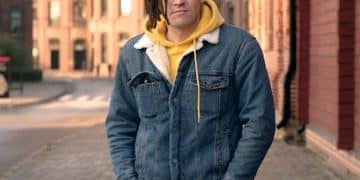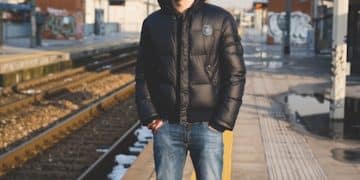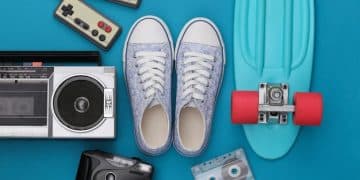How to Spot Fake Sneakers in 2025: A 7-Point Checklist
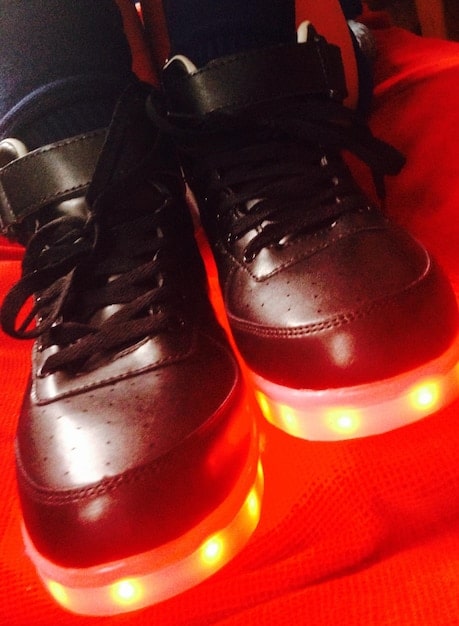
In 2025, spotting fake sneakers requires meticulous attention; our 7-point authentication checklist covers essential areas like packaging, stitching, materials, and technology to help you avoid counterfeit kicks.
Navigating the sneaker market in 2025 can be tricky, with increasingly sophisticated fakes flooding the scene. Learning how to spot fake sneakers in 2025: 7-point authentication checklist is crucial to ensure you’re investing in authentic footwear.
The Evolution of Sneaker Counterfeiting
The sneaker market has exploded in recent years, and with it, the sophistication of counterfeit operations. What was once a matter of obvious flaws is now an intricate game of cat and mouse, demanding a keen eye and up-to-date knowledge to differentiate between real and fake sneakers. Understanding this evolution is the first step in protecting your investment – keep on reading to learn how to spot fake sneakers in 2025, with our 7-point authentication checklist.
The Rise of Super Fakes
Gone are the days of easily identifiable knock-offs. Today’s “super fakes” boast near-identical construction to their genuine counterparts, making them incredibly difficult to spot. They incorporate advanced manufacturing techniques and often source materials similar to the originals.
Why Counterfeiting Persists
The high demand and limited availability of certain sneaker models fuel the counterfeit market. Resale prices for rare sneakers can reach astronomical figures, creating a lucrative incentive for counterfeiters to produce and sell fakes.
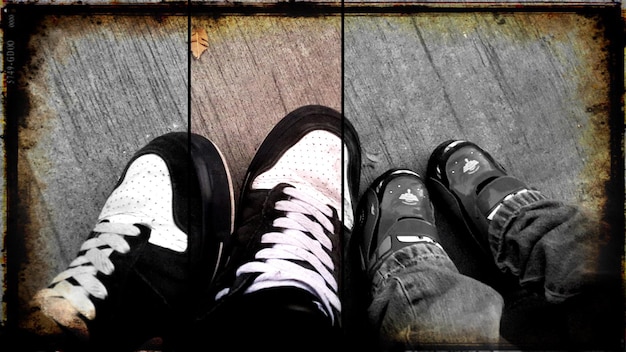
Here are some reasons why sneaker counterfeiting continues to be a problem in footwear:
- **High Profit Margins:** Counterfeiters can produce fake sneakers at a fraction of the cost of the genuine article and sell them for significant profit.
- Online Marketplaces:** The internet provides a vast and relatively anonymous platform for counterfeiters to sell their wares.
- Global Supply Chains:** Complex and opaque supply chains make it difficult to track the source of materials and production processes.
In conclusion, the sneaker counterfeiting has exploded, and demands modern techniques for authentication to avoid wasting your money in sneakers that aren’t originals. Now, let’s see the sneaker authentication process! Keep on reading to learn more.
Authentication Step 1: Packaging Inspection
The first line of defense against fake sneakers often lies in the packaging. Counterfeiters sometimes overlook the importance of replicating the box and its contents accurately. Scrutinizing the box is a crucial point if you want to know how to spot fake sneakers in 2025. Here are some tips.
Box Quality and Details
Examine the box’s material, print quality, and overall construction. Genuine sneaker boxes are typically made from sturdy cardboard with crisp, high-resolution graphics. Look for any signs of cheap materials, blurry images, or misaligned text.
Label Verification
Carefully compare the label on the box with the label inside the sneaker. The style code, size, and country of origin should match perfectly. Inconsistencies or misspellings are red flags.
- Verify the presence of a UPC code and scan it using a barcode scanner app to ensure it corresponds to the correct sneaker model.
- Check for any inconsistencies in the font, size, or placement of the text on the label.
- Examine the box for any signs of tampering, such as resealed tape or damaged corners.
To conclude this section 1, the packaging inspection is the first, and one of the most efficient verification techniques to determine if your sneakers are originals. Check every detail on the box, compare it with the label inside, and see if there are any misspellings, as these simple details can save you hundreds.
Authentication Step 2: Stitching and Construction
One of the most telling signs of a fake sneaker is often found in the quality of its stitching and overall construction. Genuine sneakers are manufactured with precision and attention to detail, which is really important if you want to learn how to spot fake sneakers in 2025, with our 7-point authentication checklist. Here are the secrets.
Stitching Consistency
Inspect the stitching throughout the sneaker. It should be uniform, tight, and free from loose threads or uneven spacing. Counterfeit sneakers often exhibit sloppy stitching with noticeable flaws.
Panel Alignment
Check the alignment of the various panels and components of the sneaker. They should fit together seamlessly, without any gaps or overlaps. Misalignment is a common indicator of a fake.
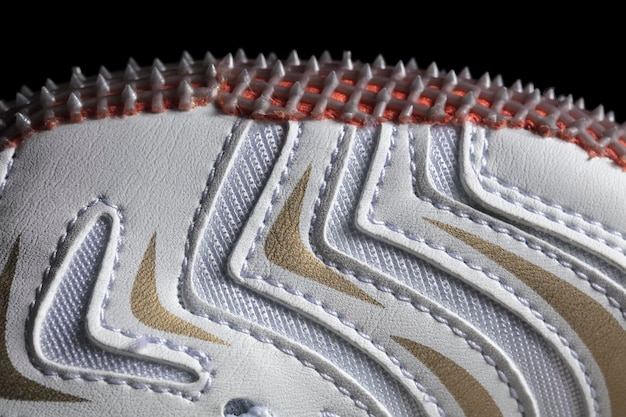
Besides stitching and consistency, pay attention to the following characteristics:
- Examine the edges of the panels for clean, precise cuts.
- Look for any signs of glue residue or other imperfections in the construction.
- Compare the overall shape and silhouette of the sneaker to images of the authentic model.
To quickly conclude this section, stitching and construction are KEY to determine if a sneaker is original, as there’s attention to detail on the original production. Check the stitching, panel alignment, look for any glue traces and compare the sneaker with the original pictures.
Authentication Step 3: Material Quality
Genuine sneakers are made from high-quality materials that are durable and authentic. In contrast, counterfeit sneakers often use cheaper substitutes that lack the same look and feel, which makes it a lot easier how to spot fake sneakers in 2025, with our 7-point authentication checklist. Here are the principal differences.
Leather Examination
If the sneaker features leather components, carefully inspect the quality of the leather. Genuine leather should feel supple and have a natural grain. Fake leather often feels stiff and synthetic.
Sole Composition
Examine the sole of the sneaker. Genuine soles are typically made from high-quality rubber or other durable materials that provide excellent traction and cushioning. Counterfeit soles may be made from cheap plastic or foam that wears down quickly.
Material quality is simple to verify, but there are still some things like:
- Assess the weight of the sneaker. Genuine sneakers often feel heavier due to the use of better materials.
- Check the lining and insole for quality and comfort.
- Inspect the laces for durability and authenticity.
To conclude, the material quality is very important to determine if your sneaker is original. Original sneakers use original materials, that are durable, flexible and comfortable. Fakes use synthetic materials that won’t last as long.
Authentication Step 4: Color Accuracy and Details
Counterfeiters frequently struggle to replicate the exact colors and fine details of genuine sneakers. Discrepancies in color, shading, or small design elements can be reliable indicators of a fake, so, pay special attention in this verification technique on how to spot fake sneakers in 2025, with our 7-point authentication checklist. Here are the details:
Color Matching
Compare the colors of the sneaker to official images from the manufacturer. Pay attention to subtle variations in hue or saturation. Fake sneakers often exhibit noticeable color differences.
Logo and Branding
Examine the logos and branding elements on the sneaker. They should be sharp, well-defined, and accurately placed. Counterfeit logos may appear blurry, distorted, or misaligned.
Here are other aspects that tell you that a sneaker is not original:
- Check for any inconsistencies in the font, size, or spacing of the text on the sneaker.
- Inspect the small details, such as the shape of the toe box or the placement of ventilation holes.
- Compare the overall aesthetic of the sneaker to images of the authentic model.
Concludingly, colors and details are a key aspect to verify on a sneaker, as fake products won’t waste resources and materials on perfecting those details, hence making it easier to discover.
Authentication Step 5: Scent Test
While it may seem unconventional, the scent test can be a surprisingly effective way to identify fake sneakers. Genuine sneakers often have a distinct smell due to the materials used in their construction. Counterfeit sneakers, on the other hand, may have a chemical or plastic-like odor, which helps you know how to spot fake sneakers in 2025.
The Smell of Authenticity
Genuine leather sneakers typically have a rich, natural leather scent. Rubber-soled sneakers may have a slight rubbery smell, but it should not be overpowering or unpleasant.
The Smell of Fakes
Counterfeit sneakers often have a strong chemical or plastic-like odor due to the use of cheap synthetic materials. This smell can be a clear indicator of a fake.
Scent test is not precise. So, here are some additional things to consider:
- Be aware that the scent of a sneaker can fade over time, so the scent test may be less effective on older sneakers.
- Consider the overall sensory experience of handling the sneaker. Genuine sneakers often feel more substantial and well-made than fakes.
- Combine the scent test with other authentication methods for a more comprehensive assessment.
Scent test helps on sneaker authentication as genuine sneakers often have distinct smells due to durable materials, while the counterfeit sneakers may have a chemical-like odor, because of the use of cheap materials.
Authentication Step 6: Blacklight Examination
A blacklight, also known as a UV light, can reveal hidden details and markings that are not visible under normal lighting conditions. This can be a valuable tool for spotting fake sneakers, as counterfeiters often overlook these subtle elements. So, use this authentication technique to know how to spot fake sneakers in 2025.
Hidden Markings
Some manufacturers incorporate UV-sensitive markings into their sneakers as a security measure. These markings may include logos, serial numbers, or intricate patterns that can only be seen under a blacklight.
Glue and Adhesive Detection
A blacklight can also reveal the presence of certain glues and adhesives used in the construction of the sneaker. Counterfeit sneakers may use different glues that fluoresce under UV light, making them easily identifiable.
Pay close attention to other details regarding this authentication technique:
- Shine the blacklight over the entire sneaker, paying close attention to the logos, seams, and other details.
- Compare the results to images of authentic sneakers examined under a blacklight.
- Be aware that the effectiveness of the blacklight test can vary depending on the materials used in the sneaker.
The blacklight examination is simple, but effective in determining sneaker originality, as many manufacturers include UV markings on sneakers for security measures. If your sneakers do not show these security UV markings, then that can be a red flag of counterfeiting.
Authentication Step 7: Price and Seller Reputation
While not a foolproof method, the price of a sneaker and the reputation of the seller can provide valuable clues about its authenticity. Be wary of deals that seem too good to be true, and always purchase from reputable sources. It’s a simple step to know how to spot fake sneakers in 2025, with our 7-point authentication checklist.
Price Discrepancies
If a sneaker is being sold for significantly less than its market value, it is likely a fake. Counterfeiters often lower prices to entice unsuspecting buyers.
Seller Verification
Research the seller before making a purchase. Check their reviews, ratings, and overall reputation. Avoid sellers with a history of selling counterfeit goods.
Also, remember to consider the following information:
- Purchase sneakers from authorized retailers or reputable resale platforms.
- Be cautious of sellers who use generic or stock photos instead of actual images of the sneaker.
- If possible, inspect the sneaker in person before making a purchase.
To conclude, always make sure to verify price discrepancies and seller verification, by researching the price of the sneakers to see if it’s too low, and researching the seller by checking reviews and purchasing ratings.
| Key Point | Brief Description |
|---|---|
| 📦 Packaging | Verify box quality, labels, and UPC code accuracy. |
| 🧵 Stitching | Ensure uniform, tight stitching without loose threads. |
| 🎨 Color Accuracy | Compare colors to official images; check logo precision. |
| 🔦 Blacklight Test | Look for hidden UV markings for authenticity. |
FAQ
▼
The most common sign is poor stitching. Fake sneakers frequently have uneven, loose, or poorly finished seams, while authentic sneakers usually have neat and consistent stitching.
▼
Fake sneakers are prevalent due to high demand, limited releases of popular models, and the potential for high profits for counterfeiters, made easier by anonymity online and social media.
▼
Yes, a blacklight can often detect fake sneakers by revealing security features like unique markings or patterns that are not visible in natural light, which counterfeiters miss.
▼
To avoid buying fake sneakers online, purchase from authorized retailers or reputable marketplaces with buyer protection policies. Always check seller reviews and authenticity guarantees.
▼
If you think you’ve bought fake sneakers, contact the seller or platform where you made the purchase immediately, and provide proof of the sneaker’s inauthenticity to seek a refund.
Conclusion
In summary, protecting yourself from counterfeit sneakers in 2025 requires a multifaceted approach, from examining packaging and construction to utilizing blacklights and verifying seller reputations. By staying informed and diligent, you can ensure that your sneaker investments are authentic and worthwhile.


